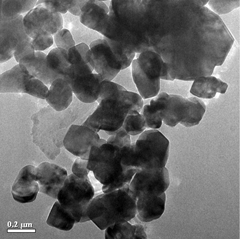Crossref Citations
This article has been cited by the following publications. This list is generated based on data provided by
Crossref.
Rozdyalovskaya, T. A.
2018.
Physicochemical Fundamentals for the Synthesis of Zinc Oxide in Molten Chlorides.
Russian Metallurgy (Metally),
Vol. 2018,
Issue. 2,
p.
163.
Khokhlov, V.
Zakir’yanova, I.
Dokutovich, V.
Shekhtman, G.
Antonov, B.
Korzun, I.
Korotkov, S.
Pankratov, A.
and
Moskalenko, N.
2019.
Modifying chemical composition of the fine Ni4Nb2O9 powders using chloride melts as reaction medium.
MRS Communications,
Vol. 9,
Issue. 4,
p.
1300.
Khokhlov, V. A.
Dokutovich, V. N.
Viugin, N. A.
and
Bobrova, K. O.
2019.
Structural and Morphological Peculiarities of the Lithium Niobate and Lithium Tantalate Powders Synthesized in Chloride Melts.
Russian Metallurgy (Metally),
Vol. 2019,
Issue. 2,
p.
90.
Khokhlov, V. A.
V’yugin, N. A.
Dokutovich, V. N.
Zakir’yanova, I. D.
and
Antonov, B. D.
2020.
Modification of the Cationic Composition of LiNbO3 and LiTaO3 Nanopowders in Calcium-Containing Chloride Melts.
Russian Metallurgy (Metally),
Vol. 2020,
Issue. 2,
p.
144.
Il'ina, E.A.
Antonov, B.D.
and
Vlasov, M.I.
2020.
Stability investigations of composite solid electrolytes based on Li7La3Zr2O12 in contact with LiCoO2.
Solid State Ionics,
Vol. 356,
Issue. ,
p.
115452.
Viugin, Nikolay A.
Khokhlov, Vladimir A.
Zakiryanova, Irina D.
Dokutovich, Vasiliy N.
and
Antonov, Boris D.
2022.
Molten Chlorides as the Precursors to Modify the Ionic Composition and Properties of LiNbO3 Single Crystal and Fine Powders.
Materials,
Vol. 15,
Issue. 10,
p.
3551.
Khokhlov, V. A.
Modenov, D. V.
Dokutovich, V. N.
Vovkotrub, E. G.
Kochedykov, V. A.
Akashev, L. A.
Malkov, V. B.
Pankratov, A. A.
and
Fetisov, A. V.
2023.
The Electrophoretic Deposition of Lithium Cobaltate Nanosized Particles on the Surface of Metals and Electroconductive Oxide Ceramics.
Russian Journal of Electrochemistry,
Vol. 59,
Issue. 2,
p.
105.
Khokhlov, V. A.
Modenov, D. V.
Dokutovich, V. N.
Vovkotrub, E. G.
Kochedykov, V. A.
Akashev, L. A.
Malkov, V. B.
Pankratov, A. A.
and
Fetisov, A. V.
2023.
The Electrophoretic Deposition of Lithium Cobaltate Nanosized Particles on the Surface of Metals and Electroconductive Oxide Ceramics.
Электрохимия,
Vol. 59,
Issue. 2,
p.
81.



